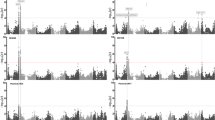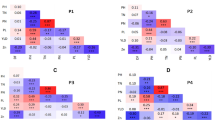Abstract
Several biologically significant parameters that are related to rice tillering are closely associated with rice grain yield. Although identification of the genes that control rice tillering and therefore influence crop yield would be valuable for rice production management and genetic improvement, these genes remain largely unidentified. In this study, we carried out functional mapping of quantitative trait loci (QTLs) for rice tillering in 129 doubled haploid lines, which were derived from a cross between IR64 and Azucena. We measured the average number of tillers in each plot at seven developmental stages and fit the growth trajectory of rice tillering with the Wang–Lan–Ding mathematical model. Four biologically meaningful parameters in this model––the potential maximum for tiller number (K), the optimum tiller time (t 0), and the increased rate (r), or the reduced rate (c) at the time of deviation from t 0––were our defined variables for multi-marker joint analysis under the framework of penalized maximum likelihood, as well as composite interval mapping. We detected a total of 27 QTLs that accounted for 2.49–8.54% of the total phenotypic variance. Nine common QTLs across multi-marker joint analysis and composite interval mapping showed high stability, while one QTL was environment-specific and three were epistatic. We also identified several genomic segments that are associated with multiple traits. Our results describe the genetic basis of rice tiller development, enable further marker-assisted selection in rice cultivar development, and provide useful information for rice production management.


Similar content being viewed by others
References
Ahmad L, Zakri AH, Jalani BS, Omar D (1986) Detection of additive and non-additive variation in rice. In: Rice genetics. IRRI, Manila, Philippines, pp 555–564
Bradshaw HD, Settler RF (1995) Molecular genetics of growth and development in populus. IV. Mapping QTLs with large effects on growth, form, and phenology traits in a forest tree. Genetics 139:963–973
Cui YH, Zhu J, Wu RL (2006) Functional mapping for genetic control of programmed cell death. Physiol Genom 25:458–469
Cui YH, Wu RL, Casella G, Zhu J (2008) Nonparametric functional mapping quantitative trait loci underlying programmed cell death. Stat Appl Genet Mol Biol 7(1), Article 4
Dong YJ, Kamiunten HS, Ogawa TF, Tsuzuki EJ, Terao HY, Lin DZ, Matsuo MH (2004) Mapping of QTLs for leaf developmental behavior in rice (Oryza sativa L.). Euphytica 138:169–175
Dou BD, Hou BW, Wang F, Yang JB, Ni ZF, Sun QX, Zhang YM (2001) Further mapping of quantitative trait loci for female sterility in wheat (Triticum aestivum L.). Genet Res 92:63–70
Gai JY, Zhang Y-M, Wang JK (2003) Genetic system of quantitative traits in plants. Science Press, Beijing
Gauch HG (1992) Model selection and validation for yield trials with interaction. Biometrics 44:705–712
Hittalmani S, Huang N, Courtois B, Venuprasad R, Shashidhar HE, Zhuang J-Y, Zheng K-L, Liu G-F, Wang G-C, Sidhu JS, Srivantaneeyakul S, Singh VP, Bagali PG, Prasanna HC, McLaren G, Khush GS (2003) Identification of QTL for growth- and grain yield-related traits in rice across nine locations of Asia. Theor Appl Genet 107:679–690
Huang N, McCouch S, Mew T, Parco A, Guiderdoni E (1994) Development of an RFLP map from a double haploid population in rice. Rice Genet Newslett 11:134–137
Iwata N, Takamure I, Wu HK, Siddig EA, Rutger JN (1995) List of genes for various traits (with chromosome and main literature). Rice Genet Newslett 12:61–93
Jansen RC (1993) Interval mapping of multiple quantitative trait loci. Genetics 135:205–211
Jiang GH, Xu CG, Li XH, He YQ (2004) Characterization of the genetic basis for yield and its component traits of rice revealed by doubled haploid population. Acta Genet Sin 31:63–72
Kao C-H, Zeng Z-B, Teasdale RD (1999) Multiple interval mapping for quantitative trait loci. Genetics 152:1203–1216
Li CC (1977) Diallel analysis of yield and its component traits in rice (Oryza sativa L.). Plant Breed Abstr 47:45
Li Z, Pinson SRM, Park WD, Paterson AH, Stansel JW (1997) Epistasis for three grain yield components in rice (Oryza sativa L.). Genetics 145:453–465
Li X, Qian Q, Fu Z, Wang Y, Xiong G, Zeng D, Wang X, Liu X, Teng S, Hiroshi F, Yuan M, Luo D, Han B, Li J (2003) Control of tillering in rice. Nature 422:618–621
Lin HX, Qian HR, Zhuang JY, Lu J, Min SK, Xiong ZM, Huang N, Zheng KL (1996) RFLP mapping of QTLs for yield and related characters in rice (Oryza sativa L.). Theor Appl Genet 92:920–927
Liu GF, Xu HM, Yang J, Zhu J (2006) Genetic analysis on tiller number and plant height per plant in rice (Oryza sativa L.). J Zhejiang Univ (Agric and Life Sci) 32:527–534
Liu G, Zeng R, Zhu H, Zhang Z, Ding X, Zhao F, Li W, Zhang G (2009) Dynamic expression of nine QTLs for tiller number detected with single segment substitution lines in rice. Theor Appl Genet 118:443–453
Ma C-X, Casella G, Wu R (2002) Functional mapping of quantitative trait loci underlying the character process: a theoretical framework. Genetics 161:1751–1762
McCouch SR, Cho YG, Yano M, Paul E, Blinstrub M, Morishima H, Kinoshita T (1997) Report on QTL nomenclature. Rice Genet Newslett 14:11–13
Murai M, Kinoshita T (1986) Diallel analysis of traits concerning yield in rice. Jpn J Breed 36:7–15
Perera ALT, Senadhira D, Lawrence MJ (1986) Genetic architecture of economically important characters and prediction of performance of recombinant inbred lines in rice. In: Rice genetics. IRRI, Manila, Philippines, pp 565–578
Plomion C, Durel CE, O’Malley DM (1996) Genetic dissection of height in maritime pine seedlings raised under accelerated growth conditions. Theor Appl Genet 93:849–858
Price AH, Tomos AD (1997) Genetic dissection of root growth in rice (Oryza sativa L.): II. Mapping quantitative trait loci using molecular markers. Theor Appl Genet 95:143–152
Sen S, Churchill GA (2001) A statistical framework for quantitative trait mapping. Genetics 159:371–387
Tanksley SD (1993) Mapping polygenes. Annu Rev Genet 27:205–233
Voorrips RE (2002) MapChart: software for the graphical presentation of linkage maps and QTLs. J Hered 93:77–78
Wang RS, Lan ZX, Ding YC (1982) Studies on mathematical models of the relationship between insect development and temperature. Acta Ecol Sin 2(1):47–57
Wang S, Basten CJ, Zeng ZB (2007) Windows QTL Cartographer 2.5. Department of Statistics, North Carolina State University, Raleigh (http://statgen.ncsu.edu/qtlcart/WQTLCart.htm)
Wu RL, Lin M (2006) Functional mapping––how to map and study the genetic architecture of dynamic complex traits. Nat Rev Genet 7:229–237
Wu P, Zhang G, Huang N (1996) Identification of QTLs controlling quantitative characters in rice using RFLP markers. Euphytica 89:349–354
Wu WR, Li WM, Tang DZ, Lu HR, Worland AJ (1999) Time-related mapping of quantitative trait loci underlying tiller number in rice. Genetics 151:297–303
Xiao J, Li J, Yuan L, Tanksley SD (1995a) Dominance is the major genetic basis of heterosis in rice as revealed by QTL analysis using molecular markers. Genetics 140:745–754
Xiao J, Li J, Yuan L, Tanksley SD (1995b) Identification of QTLs affecting traits of agronomic importance in a recombinant inbred population derived from a subspecific rice cross. Theor Appl Genet 92:230–244
Xiong ZM (1992) Research outline on rice genetics in China. China Agricultural Press, Beijing
Xu S, Jia Z (2007) Genomewide analysis of epistatic effects for quantitative traits in barley. Genetics 175:1955–1963
Xu YB, Shen ZT (1991) Diallel analysis of tiller number at different growth stages in rice (Oryza sativa L.). Theor Appl Genet 83:243–249
Yan JQ, Zhu J, He C, Benmoussa M, Wu P (1998) Quantitative trait loci analysis for the developmental behavior of tiller number in rice (Oryza sativa L.). Theor Appl Genet 97:267–274
Zeng Z-B (1993) Theoretical basis for separation of multiple linked gene effects in mapping of quantitative trait loci. PNAS 90:10972–10976
Zhang YM, Tian YQ (1995) A study on the mathematical model of egg laying in Sichuan white geese. J Southwest Agric Univ 17(6):550–552
Zhang YM, Xu S (2005) A penalized maximum likelihood method for estimating epistatic effects of QTL. Heredity 95:96–104
Zhu J (1995) Analysis of conditional genetic effects and variance components in developmental genetics. Genetics 141:1633–1639
Zou JH, Zhang SY, Zhang WP, Li G, Chen ZX, Zhai WX, Zhao XF, Pan XB, Xie Q, Zhu LH (2006) The rice high-tillering dwarf 1 encoding an ortholog of Arabidopsis MAX3 is required for negative regulation of the outgrowth of axillary buds. Plant J 48:687–696
Acknowledgments
We are grateful to the Chief Editor, Dr. Stefan Hohmann; the Communicating Editor, Dr. Stig W. Omholt; the two anonymous reviewers; and Dr. Sara J. Miller of Cornell University for their constructive comments and suggestions, which significantly improved this manuscript. This work was supported by the National Basic Research Program of China (2006CB101708), the National Natural Science Foundation of China (30971848), the Jiangsu Natural Science Foundation (BK2008335), the 111 Project (B08025) and the State Key Laboratory of Crop Genetics and Germplasm Enhancement (ZW2007001).
Conflict of interest
The authors declare that they have no conflicts of interest.
Author information
Authors and Affiliations
Corresponding author
Additional information
Communicated by S. Omholt.
G. F. Liu and M. Li contributed equally to this work.
Rights and permissions
About this article
Cite this article
Liu, G.F., Li, M., Wen, J. et al. Functional mapping of quantitative trait loci associated with rice tillering. Mol Genet Genomics 284, 263–271 (2010). https://doi.org/10.1007/s00438-010-0566-z
Received:
Accepted:
Published:
Issue Date:
DOI: https://doi.org/10.1007/s00438-010-0566-z




